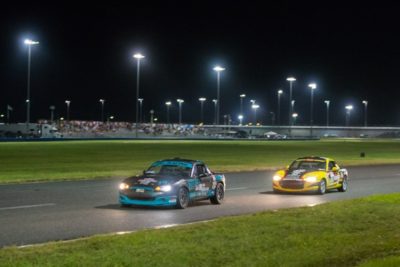Tire choice in changing conditions is critical. What’s good at the beginning of the race may not be the right choice at the end. Living with that choice until conditions change is a struggle that can be worth enduring.
Starting a wet race on dry tires when the rain has stopped can be a big gamble, but it can also be a big advantage.
We saw it in the SCCA National Championship Runoffs, when Jonathan Goring and Andrew Carbonell went with dry tires for the nighttime Spec Miata race, which saw a rain shower right before the race start. Still drizzling as the cars gathered on the grid, many teams were wrestling with which tires to use. Although Goring and Carbonell spent the first 10 laps just holding on, as they track dried, they got faster and faster. In the final six laps, they went from sixth and seventh to first and second.
Danny Bender had a similar experience in a Idemitsu Mazda MX-5 Cup Presented by BFGoodrich® Tires race at Road America. The 2014 SCCA Touring 4 National Champion started 11th on a wet track with dry tires. By the end of the race he was in first. The trick is what happens in between.
“In races, you sort of start from the beginning,” Bender explains. “I go to past experiences in different conditions on the tires. I did a club race a couple years at Mid-Ohio where I was on a drys on a much wetter track. I was leading the race, and I think the gap between the wets and drys was only about four seconds. At Road America, I knew it wasn’t going to rain again, so the track wasn’t going to get any wetter than it was. There wasn’t any standing water, so I figured the drys were going to be the best choice.
“In the wet, the guys on the wets could brake better. But I still was able to go through the corners faster, mid-corner speed-wise. So in the Carousel, there was a ton of grip on the outside I could utilize. You’ve just got to find the advantage, where the drys are going to be better. So I was able to use it mostly on the exit of the corners, getting out of corners to be able to get a run to the next one, that was where I was able to use them the most.”
Using the out laps and pace laps to experiment and find the grip, if it’s a track you haven’t been on in the wet, could greatly help you in the race. And you don’t have to be going fast to figure it out.
“When you’re scrubbing the tires, feel the car – does the inside have more grip? Does the outside?” Bender says. “When you’re going into the braking zone, you’re not going fast enough to lose control, so slam on the brakes on the inside, slam on the brakes on the outside, and feel where there is more grip. Then use that knowledge in the race.”
Bender did that, to good effect. So did Goring and Carbonell at the Runoffs. A driver that chooses to gamble by starting a wet race on dry tires may regret that choice for the first part of the race; but if the track dries out, or at least a dry line appears, that gamble could pay off handsomely.


 ACCESSIBILITY
ACCESSIBILITY